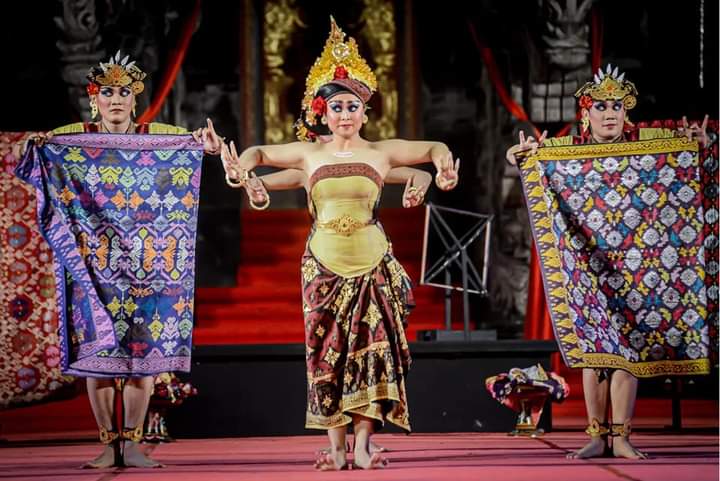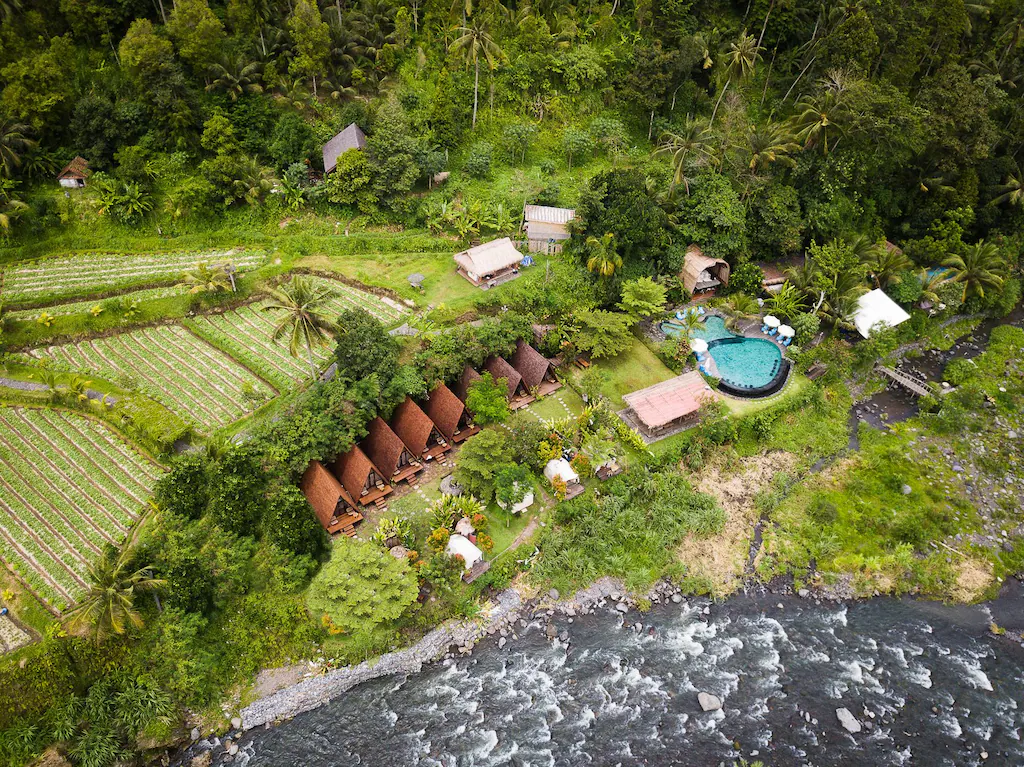Sidemen, tucked into the fertile folds of East Bali’s Karangasem Regency, is a place where the island’s old soul still thrives. It is a valley where rice paddies unfurl in neat terraces, bamboo forests sway gently in the wind, and Mount Agung watches from the horizon with silent majesty. For those weary of Bali’s busier centers, Sidemen offers a retreat into authenticity.
Unlike Ubud, which pulses with yoga studios, boutiques, and international cafés, Sidemen invites you into an atmosphere that is quieter and more personal. There are no crowds, no endless rows of shops. Instead, you will find the rhythm of roosters, the fragrance of frangipani carried on the breeze, and the gentle hum of irrigation streams. This combination of simplicity and spirituality makes Sidemen not only a destination but also an experience of slowing down.
Landscape of Serenity
Sidemen’s terrain is shaped by contrasts. The valley floor is a patchwork of rice terraces, woven together by the Subak irrigation system. Hills roll upward into dense forests where clove and cocoa trees grow, and beyond them rises Mount Agung, its peak often veiled by mist. Every hour the light changes, casting different moods across the valley.
The Subak, recognized by UNESCO, is a philosophy as much as an engineering marvel. Rooted in the principle of Tri Hita Karana — harmony between humans, nature, and the divine — it ensures fair water distribution while reinforcing community ties. In Sidemen, farmers still meet at water temples to discuss cycles of planting, showing how tradition continues to shape agriculture.
For visitors, the valley is best discovered on foot. Treks lead through paddies edged with shrines wrapped in yellow and white cloth. Along the way, you may encounter farmers bent over seedlings, children chasing ducks, and women carrying baskets of offerings. Each encounter feels unfiltered, a reminder that Sidemen is not a staged attraction but a living community.
Sound and Spirit of Daily Life

Daily life in Sidemen unfolds at a pace that feels timeless. At dawn, temple bells echo softly across the valley, announcing morning prayers. Farmers begin their work with chants that blend into the natural soundscape of flowing water and bird calls. By mid-morning, the weaving workshops open, and the rhythmic click of wooden looms can be heard as women create songket, Bali’s most ornate textile.
Evenings bring a different mood. Smoke rises from wood fires as families prepare dinner, while gamelan rehearsals spill into the air from the banjar halls. Travelers often pause to listen, captivated by the syncopated tones of bronze instruments and the dance movements practiced by young children in ceremonial dress. 📸🌺
This immersive soundscape reinforces what makes Sidemen unique: culture is not a performance for outsiders, but a way of life shared generously with those who visit respectfully.
Cultural Insight

Sidemen is deeply connected to tradition, most visibly through its craft. The weaving of songket is a proud heritage, with motifs passed down through generations. Each pattern is tied to a story: fertility, guardianship, prosperity, or cosmic balance. Watching a weaver at work is humbling. Every thread is placed with patience, the gold or silver filaments catching the light as the design slowly takes form.
Temple ceremonies remain central. Each desa has its pura puseh (temple of origin) and pura dalem (temple of the dead), where offerings and rituals mark the cycle of life. The annual odalan transforms the village with banners, gamelan orchestras, and sacred dance. For travelers, witnessing such a festival is unforgettable, provided it is done with respect. Cover shoulders and knees, wear a sarong, and avoid stepping into processions.
This temple ritual is a living, breathing legacy, one that continues to ground Sidemen even as more visitors arrive. It is here that you feel Bali’s spiritual essence most directly, unpolished yet deeply moving.
Beyond the Main Destination
Sidemen is often compared to Ubud, and for good reason. Both offer rice terraces, craft traditions, and spiritual depth. Yet Ubud’s streets are now lined with shops and traffic, while Sidemen’s lanes remain quiet. This contrast appeals to those who want the cultural richness without the bustle.
To understand Sidemen’s place in Bali, it helps to compare nearby destinations:
- Ubud: A hub for wellness, yoga, and art, Ubud attracts international communities. Sidemen is more intimate and village-oriented.
- Jatiluwih: Known for sweeping rice terraces, Jatiluwih impresses with scale. Sidemen, by contrast, offers smaller landscapes where you meet the farmers themselves.
- Tenganan: This Bali Aga village near Candidasa preserves pre-Hindu customs, including double ikat weaving. Sidemen complements it with songket traditions, offering two different threads of heritage.
Together, these destinations reveal the diversity of Bali. Sidemen stands out as the middle path — accessible, authentic, and spiritually rich.
Traveler Experiences
Travelers often speak of Sidemen as a place where itineraries dissolve. The valley encourages spontaneity. One morning you may rise early for a trek that winds past waterfalls and clove plantations, while another morning is best spent on a veranda, watching mist roll over Mount Agung.
A sample day might look like this:
- Begin at dawn with herbal tea as roosters call across the valley.
- Join a guided trek that includes a stop at a songket workshop and a village temple.
- Share lunch at a roadside warung, enjoying nasi campur wrapped in banana leaves.
- Spend the afternoon in a spa perched over rice paddies, where massages use coconut oil and frangipani petals.
- End the day with arak tasting, accompanied by gamelan music played by local youth.
Winding trails echo a living, breathing story of timeless beauty. For many, this combination of landscape, culture, and hospitality creates the most memorable part of their Bali journey.
Practical Tips
- Best time to visit: April to October offers clear skies, but November to March brings lush greenery and fewer crowds.
- Getting there: Sidemen is 90 minutes from Denpasar and one hour from Ubud. Private drivers are recommended, as public transport is limited.
- Dress code: Light, breathable clothing for trekking. A sarong is essential for temple visits.
- Local etiquette: Greet villagers with a smile. Always ask before photographing ceremonies or people.
- Costs: Meals in warungs can cost as little as 30,000 IDR, while boutique villas can reach millions per night.
Activities and Adventures
Beyond relaxation, Sidemen offers unique experiences that connect you with the valley.
- Weaving workshops: Learn the basics of songket weaving from local artisans.
- Cooking classes: Join families in preparing dishes like lawar, satay, and sambal, often using vegetables grown in their own gardens.
- Cycling tours: Pedal through backroads, passing temples, rivers, and untouched villages.
- White-water rafting: The nearby Telaga Waja River offers rafting adventures, combining adrenaline with scenery.
- Spiritual encounters: Some homestays arrange visits with local priests for blessings or meditation sessions.
These activities ensure that Sidemen is not only a retreat but also a place of discovery.
Luxury Hotel Picks in Sidemen and Surrounding Valleys

Here are luxury stays that let you immerse in the valley’s quiet magic:
Luxury Hotel Picks in Sidemen and Surrounding Valleys
Here are luxury stays that let you immerse in the valley’s quiet magic:
Amankila
Perched in East Bali near Manggis, offering Aman’s signature luxury within reach of Sidemen. Check Here
Wapa di Ume Sidemen
A serene resort with infinity pools facing Mount Agung, perfect for meditation and slow mornings. Check Here
The Wapa Lux Tent
Elegant tented suites set amid green hills. An intimate choice for design lovers who want a close to nature feel. Check Here
NUMA Bali Hotel
Contemporary lines meet valley calm. A smart base for explorers who want comfort after long treks. Check Here
Villa Lumbung Sidemen
Traditional lumbung style architecture with sweeping rice terrace vistas. Ideal for culture forward stays. Check Here
Samanvaya Luxury Resort & Spa — Adults Only
Bamboo accents and spa rituals with local herbs. Suits guests seeking wellness time and an intimate setting. Check Here
Natya River Sidemen
A riverside sanctuary with elegant villas and flowing water views. Perfect for travelers seeking tranquility close to authentic village life. Check Here
Sidemen is not merely a stop on a Bali itinerary — it is a sanctuary where travelers are invited to experience life at its natural pace. Here, the balance between culture and nature remains intact, allowing visitors to witness ceremonies, taste authentic food, and rest in landscapes shaped by centuries of tradition.
The valley is alive in subtle ways. The smell of rain on earth, the sight of farmers moving in harmony with the Subak, and the sound of weaving looms all remind you that this is a place where human life and environment are still intertwined.
For travelers, Sidemen offers more than beauty. It offers perspective: a reminder that the most profound journeys are not measured by how much you see, but by how deeply you connect.
This guide was crafted with local expertise, part of an ongoing series by the team at BaliExpertGuide.com to promote responsible and immersive travel across the island.